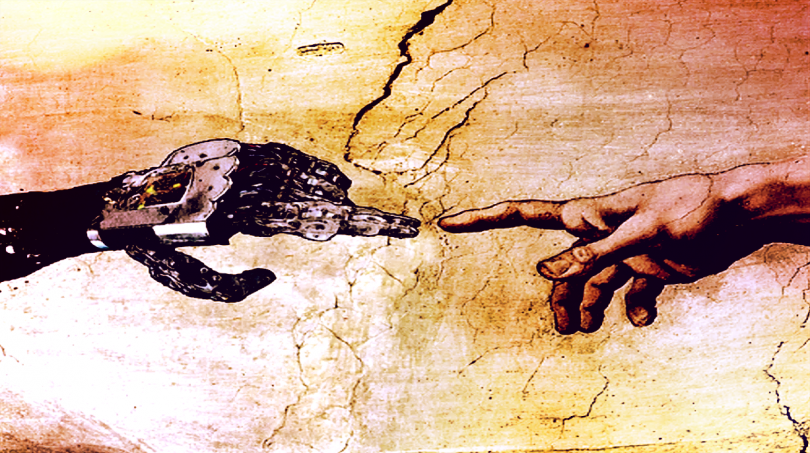The following is adapted from Kirk Schneider’s The Spirituality of Awe: Challenges to the Robotic Revolution.

aNewDomain — The sense of awe — or humility and wonder, sense of adventure toward living — is becoming a cherished value these days..
This is clear not only from the spiritual searching with which more people are engaged but from the increasing research on awe’s benefits both to individuals and society as a whole.
For example, studies have shown that the sense of awe increases our tolerance for differences, patience, gratitude toward life, and willingness to help others.
It also brings a sense of fulfillment and life-satisfaction for many people, and this in turn seems to translate into their concern about strengthening and deepening human bonds. Yet ironically, it is equally clear that political and psychological polarization is also growing.
This problem was dramatically illustrated by the recent assault charges leveled against Montana Congressman Greg Gianforte for “body slamming” a freelance reporter for his allegedly “aggressive” questions; it was also evident in the recent cancelations of conservative speakers by some liberal administrators–as well as the recent series of violent attacks by fanatics, both Left and Right. But this problem is by no means confined to politicians and the press.
The surging animus between Democrats and Republicans, the working class and the wealthy, and people of color and law enforcement is driving a wedge at the very heart of our traditions of civility. This problem is compounded moreover by our quick-fix, instant result society fostered at least in part by AI. For example, think of all the militarization, automatic weaponry, and algorithmic programming that goes into feuding factions!
What then can be done to stem the tide? Well, there have been many proposals, from appeals to political moderates, to media programs, such as CNN’s “The Messy Truth,” featuring dialogues on controversial social issues, to politicians’ participation in Town Hall style debates, the collective impact of these efforts does not seem to be having the desired effect.
Indeed, the fundamental rifts in our society remain and the prospects for healing those rifts are not encouraging, as poll after poll repeatedly demonstrate.
As a clinical psychologist, I have witnessed some of the most conflicted parties find footholds and even remarkable turnabouts via the “right” therapeutic means. I have seen some of the most estranging transactions turn conciliatory given the optimal attention.
The Bottom Line
If we are to genuinely attack the crisis of polarization in this world–if we are to substantively combat human fear and reactivity–we will need to reprioritize our energies.
We will need to reprioritize our conciliation efforts on a much larger scale. What would this scale look like? Well, given the urgency of this problem, I would describe the scale on a par with what the germinal American philosopher William James called the “moral equivalent of war.” I
ndeed, pursuing the metaphor further, I would even go so far as to call for an “army” of conflict mediators schooled in “awe-based” in depth facilitation. Specifically, this army would be comprised of psychologically minded, rigorously trained social healers equivalent to the current army of rigorously trained warriors.
The army would also be the byproduct of a new social contract in our society. This contract would give major incentives to therapists, educators, managers, doctors, lawmakers, clergy and the like to receive specialized training in the mediation of conflicts throughout our society and potentially, world.
These would be mediations that cultivate candid, personal engagements among people, and not just behavioral or intellectual change. The kind of change I am speaking about here attempts to address people’s whole bodied experience of each other and not just changes of routine.
What we’ll need of course is first, the recognition of the enormity of the problem, and second, the will to shift resources to address it.
But instead of the currently proposed upsurge of tax payer dollars for military expenditures, how about even a fraction of that for pilot programs that could begin the kind of awe-based, sensitively facilitated dialogues that could curb the need for militaries in the first place.
Such dialogues moreover, are already taking place, albeit at a fraction of the scale necessitated, in some of the least expected settings.
Consider, for example, the work of veteran facilitators Libby and Len Traubman. On October 1, 2009 the Traubman’s, prominent for their “living room” dialogues between Palestinians and Israeli’s, conducted a group facilitation at a community center in Fresno, California.
Watch a video of their facilitation under the title “Crossing the Lines in Fresno: Stories as Entry to Relationship and Change,” below.
CROSSING LINES IN FRESNO (documentary – 29 min) from Libby and Len Traubman on Vimeo.
At this remarkable gathering, featuring some 80 ethnically and religiously diverse people, the Traubmans began by telling some stories about their own lives. Following these anecdotes, they then extolled the power of dialogue as an entrée into deep and sometimes life-changing discoveries about how others live. They emphasized how we typically presume so much about people without really getting to know them and without humbling ourselves to make room for that intimate knowledge.
The Traubmans also emphasized how often they’ve seen such personal and interpersonal discoveries as foundation stones for more caring communities, as well as more enriched and open communities. From my perspective, their approach highlights how awe—the humility and wonder or sense of adventure toward living—has the potential for profound interpersonal as well as personal change.
Following the Traubmans’ introduction, they set forth a format that can be used, and indeed that they highly encouraged to be used in virtually any communal setting in the world. They recognized that it is not the “end all and be all” of communal harmonization, but that it can be a very critical step toward such harmonization, or at the least, enrichment and co-existence.
The Traubmans began this phase by soliciting brief statements from people in the audience about what brought them to the workshop. This helped people begin to get to know each other more as fellow human beings rather than simply “audience members” or shallow stereotypes.
The Traubmans then defined “dialogue” as comprising “you, me, and us,” as distinct from “discussions” that are often more didactic or intellectualized in nature, like one person “talking at” versus “talking with” another. They suggested that people acknowledge that their worldview is limited and try to connect with their heart and not just their head, or in essence, that they “listen to learn.”
Then people were asked to pair up with someone they didn’t know and ideally even felt some discomfort with, or someone they perceived they might “not get along with so well.” They then were instructed to sit across from one another “eye-to-eye.”
For the first 15 minutes one partner was asked to be the “story teller” and the other to be the “listener.” The story teller had 10 minutes to tell their story without interruption, while the listener remained as mindfully present with them as possible.
The storyteller was asked to describe what it was like to grow up with their families, particularly their parents and grandparents or any other people or places they felt comfortable illuminating. Then the Traubmans emphasize the following: While you are telling your stories be sure to include this: What were you taught about people who were unlike you? What were you taught about people outside your family, outside your circle, outside your faith? In short, what were you taught about the “other” as you were growing up?
For the last five minutes then, the listener was asked to explore and expand on the teller’s story. The roles were then reversed and the listener became the teller and the teller the listener.
This final round was then followed by a “process” period where listener and teller were asked to stay near each other and participate in a dialogue with the entire group. “What was it like to be together?” the Traubmans asked. “What was the quality of listening, and what did you experience? Be courageous here …” People then shared their stories and there were many expressions of goodwill and appreciation for their partners’ honest sharing.
Partners also expressed both humility and wonder at both the commonalities they experienced as human beings, as well as the radical differences, particularly in cultural and familial environments. But the strongest thread seemed to be the sense of being more fully understood and appreciated as a human being rather than the particular religious or cultural identity one is “stamped” with. The capacity to “reach across” and appreciate the “otherness” of the partner was also vital.
The stage appeared to be set for a fuller and more intensive conversation about “hot button” issues tearing many in our world apart.
Another example of how markedly diverse individuals who have moderate knowledge of each other could successfully engage in an awe-based, in depth dialogue took place on Sunday, March 20, 2016. I facilitated this engagement, which I termed an “experiential democracy dialogue,” between Nathaniel Granger, an African American social activist and Rodger Broome, a Caucasian police officer at the Society for Humanistic Psychology Annual Conference at San Francisco State University.
Watch it below:
The focus of the dialogue was the experience of community policing, and the two dialogue partners were mature, highly educated adults who had some prior knowledge of, and respect for, one another. Although these partners were not wholly representative of the activist and police communities en masse, they nevertheless provided a powerful model in my and others’ estimation of how such communities could convey their respective experiences, feel “heard,” and begin the process of social healing.
The dialogue was comprised of four basic stages: 1) a turn-taking stage where each partner had a chance to deeply and mindfully “tell their side of the story” in regard to community policing; 2) a feedback and correction stage where the listener mirrored back to the teller what he heard and the teller corrected any gaps he experienced in the feedback; 3) a processing stage where, with the help of the facilitator, the parties elaborated on and deepened their perspectives, as well as their responses to each others’ perspectives; and 4) a results stage, where the parties were asked if they’d achieved common ground, or even a basis for common ground, along with any possible recommendations for changes in community policing policies.
While there were many illuminating moments in this exchange, one overarching aspect stood out. It showed how a safe, contained and concertedly present environment links with empathy, discovery and an expanded potential for bridge-building. Although clearly uncomfortable with each other at points, both parties agreed that the process was valuable. It not only helped them to more fully understand each other but also convinced them of the value and indeed, urgency, of a similar process for the training of police. Their views, it turns out, are not isolated examples. In a recent study of racial bias and law enforcement in psychology’s flagship journal the American Psychologist, authors Alison Hall, Erika Hall, and Jamie Perry concluded that “self-awareness,” “increased intergroup contact,” and “perspective taking and giving” were key to effective policing.
To sum, the above two dialogues are noteworthy illustrations of an awe-based approach to polarization. While we emphatically need short-term, behaviorally-focused “strategies” for polarized communities, we also need to dig deeper and discover ourselves as whole human beings.
To that extent we support the humility and wonder–sense of adventure toward living–that can, in principle, lead to enduring cultural and personal transformation.
For aNewDomain, I’m Kirk Schneider.













